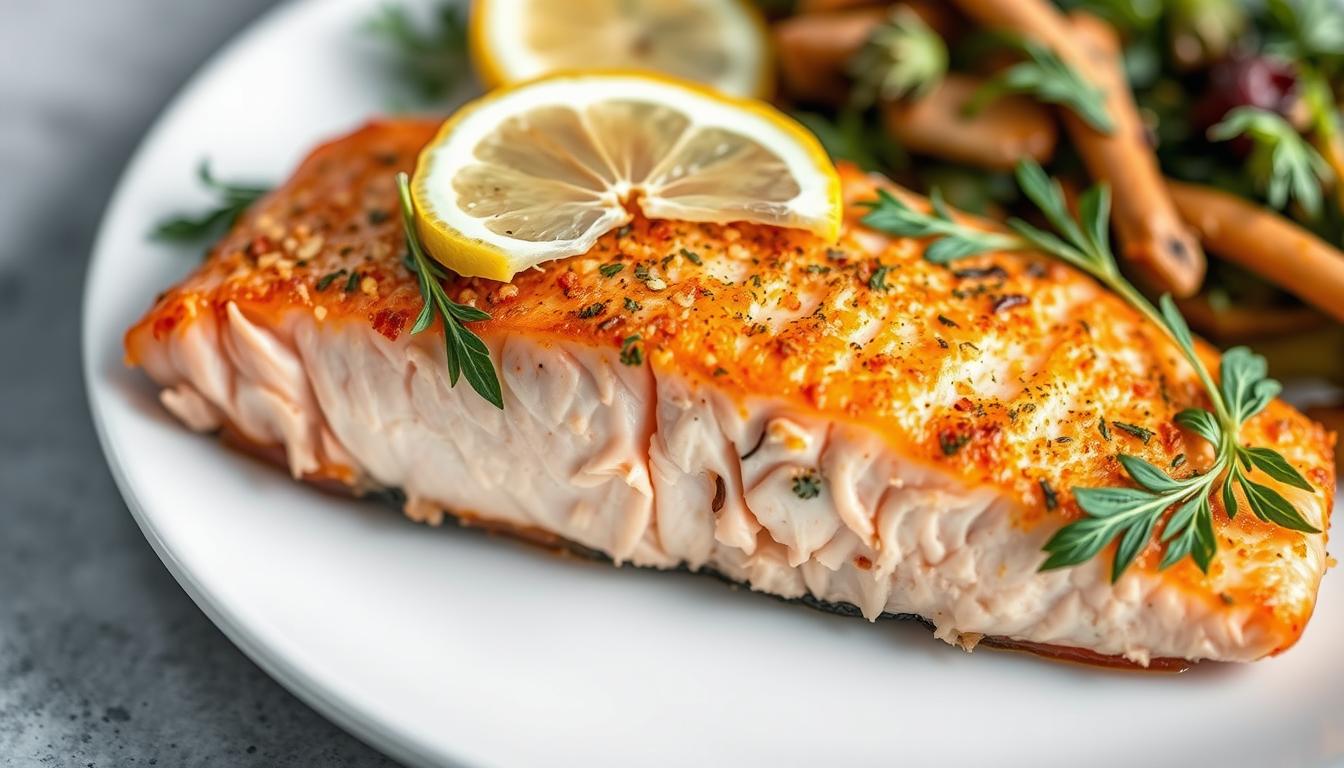Why Salmon is a Great Choice for Families
Salmon is not only delicious but also packed with nutrients that benefit the whole family. This versatile fish is rich in high-quality protein, omega-3 fatty acids, and essential vitamins and minerals that support heart and brain health.
Nutritional Benefits
- Excellent source of protein (about 34g per 6oz serving)
- Rich in omega-3 fatty acids for heart and brain health
- Contains vitamin D, which many people are deficient in
- Good source of B vitamins, especially B12
- Provides potassium, selenium, and antioxidants
Family-Friendly Features
- Mild flavor that appeals to children and adults alike
- Quick cooking time (under 15 minutes for most methods)
- Versatile – can be seasoned in countless ways
- Available year-round in most grocery stores
- Can be prepared with simple ingredients

When selecting salmon for your family, look for fillets with bright, moist flesh and a fresh, mild scent. The color should be vibrant pink to deep orange, depending on the variety. For the best results, choose center-cut pieces that are uniform in thickness for even cooking.
Learn more about the health benefits of including salmon in your family’s diet from the Seafood Nutrition Partnership.
Essential Tools for Cooking Salmon
Having the right equipment makes cooking salmon much easier and helps ensure perfect results. Here are the basic tools you’ll need:
For Pan-Searing
- Heavy-bottomed skillet (cast iron or stainless steel)
- Fish spatula or wide turner
- Instant-read thermometer
- Paper towels for patting dry
- Basting spoon for butter basting
For Baking
- Rimmed baking sheet
- Parchment paper or aluminum foil
- Instant-read thermometer
- Pastry brush for oil or butter
- Oven mitts
For Grilling
- Fish grilling basket or foil
- Long-handled tongs
- Instant-read thermometer
- Basting brush
- Grill scraper

“The right tools make all the difference when cooking salmon. An instant-read thermometer is particularly valuable as it takes the guesswork out of knowing when your salmon is perfectly done.”
How to Cook Salmon Perfectly: Step-by-Step Guide
There are several excellent methods for cooking salmon, each producing different results. We’ll cover the three most popular techniques: pan-searing, baking, and grilling. No matter which method you choose, there are some universal steps to follow first:
Preparation Steps for All Methods
- Remove salmon from refrigerator 15-30 minutes before cooking to bring to room temperature
- Pat salmon dry thoroughly with paper towels
- Season with salt and pepper (and any other desired seasonings)
- Prepare your cooking surface and tools before starting
Pan-Seared Salmon
Pan-searing creates a delicious crispy exterior while keeping the inside moist and tender. This method works best with skin-on fillets.
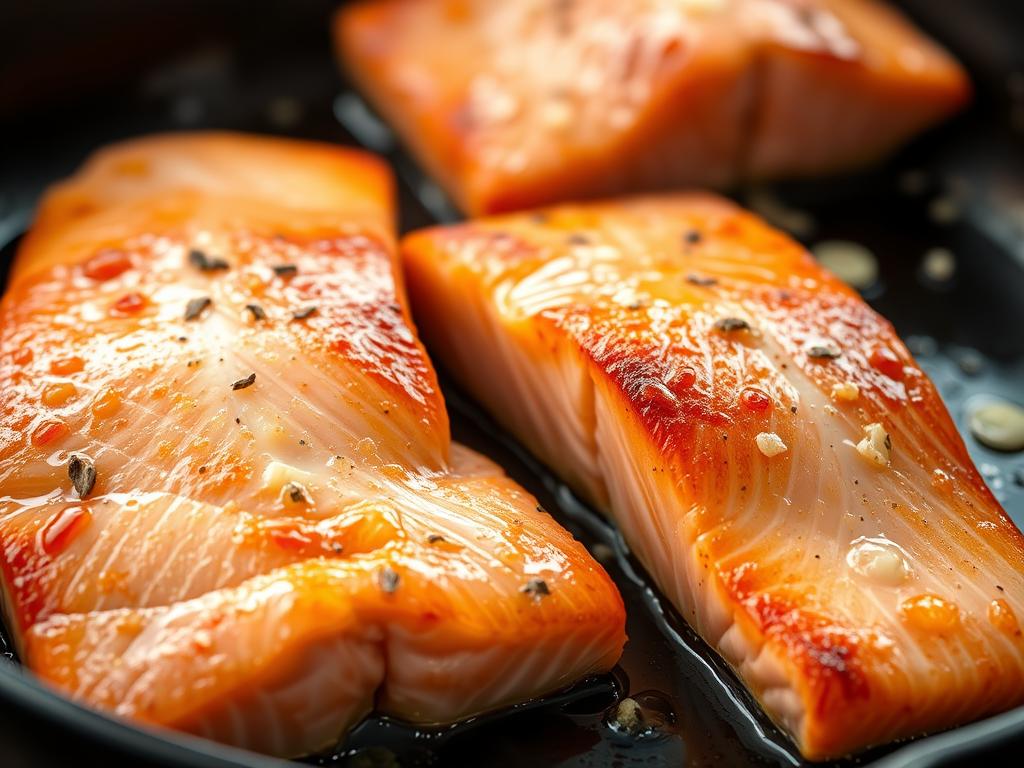
| Step | Instructions | Time | Tips |
| 1 | Heat a heavy skillet over medium-high heat until very hot | 2-3 minutes | The pan should be hot enough that water droplets sizzle and evaporate immediately |
| 2 | Add oil with a high smoke point (like vegetable or avocado oil) | 30 seconds | Use just enough oil to coat the bottom of the pan |
| 3 | Place salmon skin-side down (or presentation side down if skinless) | 4 minutes | Don’t move the salmon during this time to allow crust to form |
| 4 | Flip salmon carefully with a fish spatula | 10 seconds | If the salmon sticks, it’s not ready to flip yet |
| 5 | Add butter, garlic, and herbs if desired, and baste the salmon | 2-3 minutes | Tilt the pan and spoon the butter over the salmon continuously |
| 6 | Check internal temperature (aim for 120-125°F for medium-rare, 130°F for medium) | 30 seconds | Insert thermometer into the thickest part of the fillet |
| 7 | Rest salmon before serving | 3 minutes | Temperature will rise 3-5°F during resting |
View Recipe
Baked Salmon
Baking is one of the easiest and most hands-off methods for cooking salmon. It’s perfect for when you’re preparing other dishes simultaneously.
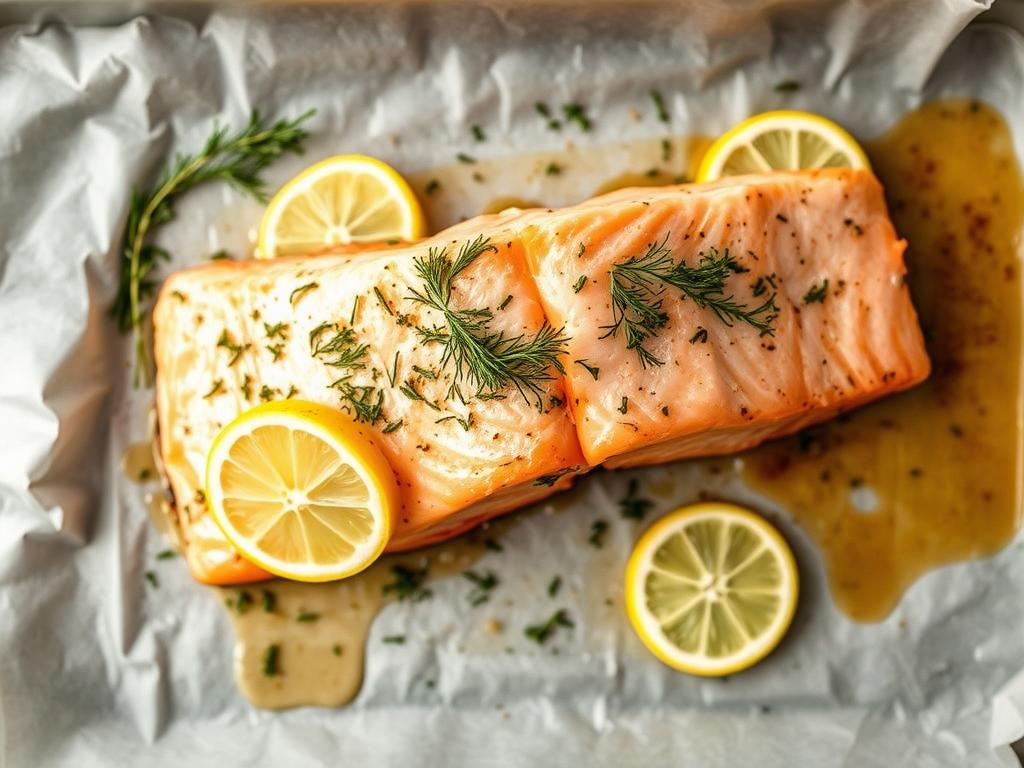
- Preheat your oven to 375°F (190°C)
- Line a baking sheet with parchment paper or foil
- Place seasoned salmon on the sheet (skin-side down if applicable)
- Drizzle with olive oil and add lemon slices if desired
- Bake for 12-15 minutes, depending on thickness
- Check internal temperature (125-130°F)
- Rest for 3-5 minutes before serving
Pro Tip: The 10-Minute Rule
A general guideline for baking salmon is to cook it for 10 minutes per inch of thickness, measured at the thickest part. This works for most oven temperatures between 350-425°F. Always verify with a thermometer for perfect results.
Grilled Salmon
Grilling adds a wonderful smoky flavor to salmon and is perfect for summer cooking. It works well for larger fillets or salmon steaks.

- Preheat grill to medium-high heat (375-400°F)
- Oil grill grates thoroughly to prevent sticking
- Place salmon skin-side down on the grill
- Close the lid and cook for 4-6 minutes without moving
- Carefully flip the salmon using a wide spatula
- Grill for another 2-4 minutes until desired doneness
- Check internal temperature (125-130°F)
- Rest for 3-5 minutes before serving
Simple Ways to Flavor Your Salmon
One of the best things about salmon is how well it pairs with different flavors. Here are some simple yet delicious ways to season your salmon:
Classic Lemon Herb
- 2 tablespoons olive oil
- 1 tablespoon fresh lemon juice
- 2 cloves minced garlic
- 1 teaspoon dried herbs (thyme, dill, or parsley)
- Salt and pepper to taste
Garlic Butter
- 3 tablespoons butter
- 3 cloves minced garlic
- 1 teaspoon lemon juice
- 1 teaspoon fresh parsley, chopped
- Salt and pepper to taste
Honey Mustard
- 2 tablespoons honey
- 1 tablespoon Dijon mustard
- 1 tablespoon olive oil
- 1 clove minced garlic
- Salt and pepper to taste

“The key to perfectly flavored salmon is to enhance, not overpower, its natural taste. Simple seasonings often yield the most delicious results.”
For best results, season your salmon just before cooking. If using marinades, limit marinating time to 30 minutes maximum, as the acid in marinades can start to “cook” the fish if left too long.
Common Mistakes to Avoid When Cooking Salmon
Even experienced home cooks can make these common errors when preparing salmon. Avoiding these mistakes will help ensure your salmon turns out perfectly every time:
What To Do
- Pat salmon dry before cooking for better browning
- Let salmon come to room temperature before cooking
- Use a thermometer to check for doneness
- Allow salmon to rest after cooking
- Cook skin-on salmon skin-side down first
What To Avoid
- Overcooking (salmon continues cooking after removed from heat)
- Moving the salmon too soon when searing
- Using too low heat when pan-searing
- Removing the skin before cooking (it helps protect the flesh)
- Seasoning too far in advance (salt draws out moisture)
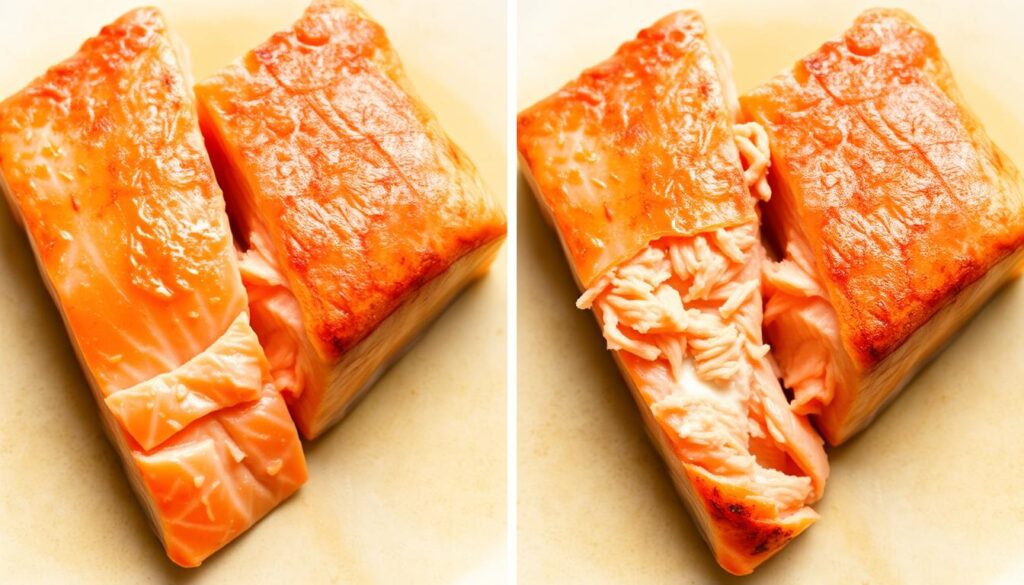
The #1 Mistake: Overcooking salmon is the most common error. Remember that salmon will continue cooking for a few minutes after you remove it from the heat source. For perfect doneness, remove salmon when it reaches an internal temperature of 125°F for medium doneness (it will rise to about 130°F while resting).
How to Tell When Salmon is Perfectly Cooked
Knowing exactly when salmon is done can be tricky. Here are several reliable methods to ensure perfectly cooked salmon every time:
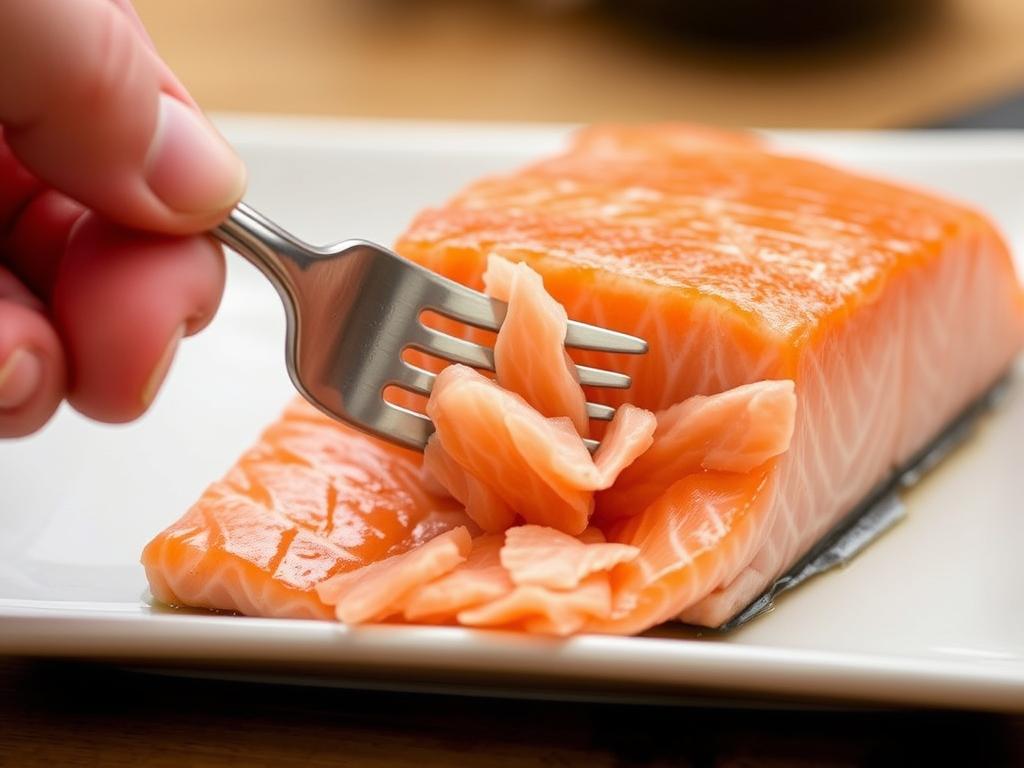
Visual Cues for Doneness
If you don’t have a thermometer, you can use these visual indicators:
- Color change: Salmon will change from translucent to opaque as it cooks
- Flaking test: When salmon flakes easily with a fork but still maintains moisture, it’s done
- White protein: Small amounts of white protein (albumin) appearing on the surface is normal, but excessive amounts indicate overcooking
- Firmness test: Gently press the top of the salmon – it should be firm but still give slightly
Learn more about salmon nutrition and safe cooking temperatures from Seafood Health Facts, a joint project with the Universities of Oregon State, Cornell, Delaware, Rhode Island, Florida, and California.
Serving Suggestions and Side Dishes
Perfectly cooked salmon pairs beautifully with a variety of side dishes. Here are some family-friendly options to complete your meal:
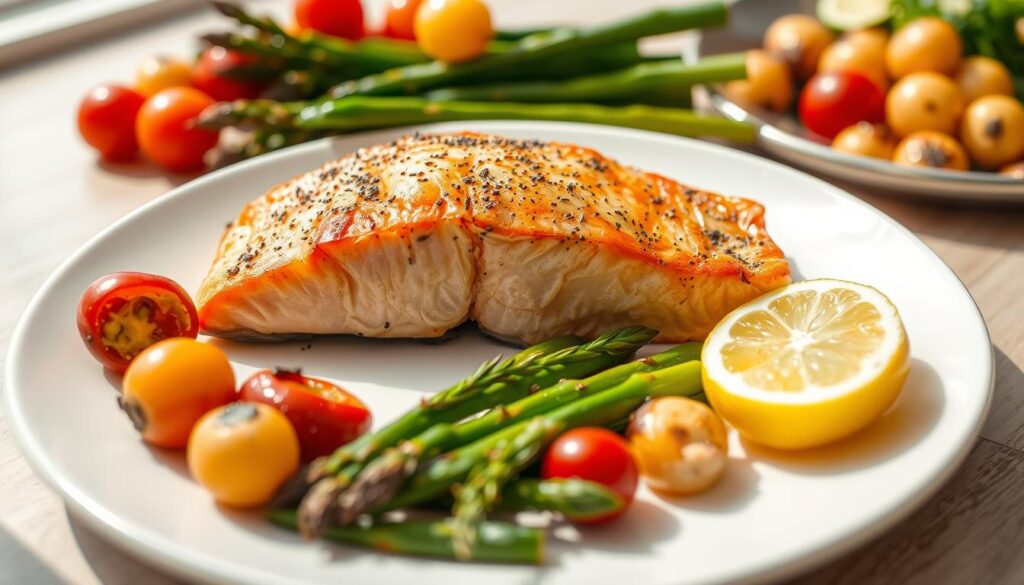
Quick Side Dishes (Under 15 Minutes)
- Steamed asparagus with lemon
- Simple green salad with vinaigrette
- Microwaved or steamed vegetables
- Quick-cooking couscous or quinoa
- Store-bought bread with olive oil
Make-Ahead Side Dishes
- Roasted vegetables (broccoli, carrots, potatoes)
- Cauliflower or potato mash
- Rice pilaf or wild rice blend
- Pasta salad with vegetables
- Cucumber and tomato salad
Sauces to Complement Salmon
- Lemon dill yogurt sauce
- Cucumber tzatziki
- Simple herb butter
- Dijon mustard sauce
- Mango or pineapple salsa
Perfect Pairing
For a nutritious and balanced meal, enjoy your perfectly cooked salmon with a side of easy roasted vegetables. Combining fish and vegetables not only enhances flavor but also offers proven health benefits, as highlighted by Harvard T.H. Chan School of Public Health. Ready in just 25 minutes while your salmon rests!.
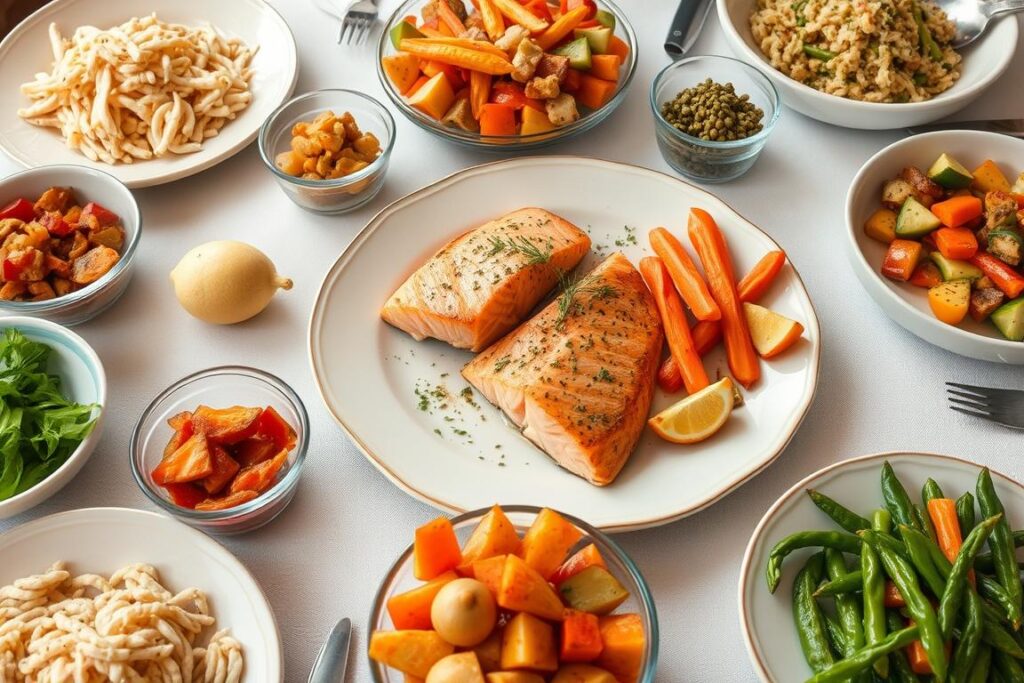
Frequently Asked Questions
How do I know when salmon is done cooking?
The most reliable method is using an instant-read thermometer inserted into the thickest part of the fillet. For medium doneness, aim for 125-130°F. Without a thermometer, look for these signs: the salmon should flake easily with a fork while still maintaining moisture, change from translucent to opaque, and feel slightly firm but still give when gently pressed.
Can I cook salmon from frozen?
Yes, but it’s not ideal. If you must cook from frozen, add about 50% more cooking time and use the baking method. For best results, thaw salmon overnight in the refrigerator or use the quick-thaw method: place the sealed frozen salmon in cold water for 30 minutes, changing the water every 10 minutes.
Should I remove the skin before cooking salmon?
It’s generally better to cook salmon with the skin on, even if you don’t plan to eat it. The skin provides a protective barrier between the heat source and the delicate flesh, helping prevent overcooking. It also contains healthy fats and becomes deliciously crispy when pan-seared properly. You can easily remove it after cooking if preferred.
What’s the white stuff that comes out of salmon when cooking?
That white substance is called albumin, a protein that coagulates and becomes visible when salmon is cooked. Some albumin is normal, but excessive amounts indicate overcooking. To minimize albumin, cook salmon at a lower temperature, brine it briefly before cooking (10 minutes in salt water), or use the gentle poaching method.
How long can I store leftover cooked salmon?
Properly stored in an airtight container, cooked salmon will last 3-4 days in the refrigerator. For best quality, reheat gently in a 275°F oven until just warmed through (about 15 minutes), or enjoy cold in salads and sandwiches. Cooked salmon can also be frozen for up to 2-3 months, though the texture may change slightly upon thawing.
Master the Art of Perfectly Cooked Salmon
Learning how to cook salmon perfectly is a valuable skill that will serve you and your family for years to come. With the techniques and tips shared in this guide, you’ll be able to prepare delicious, nutritious salmon meals with confidence. Remember that practice makes perfect, so don’t be discouraged if your first attempt isn’t flawless. Each time you cook salmon, you’ll develop a better sense of timing and doneness.
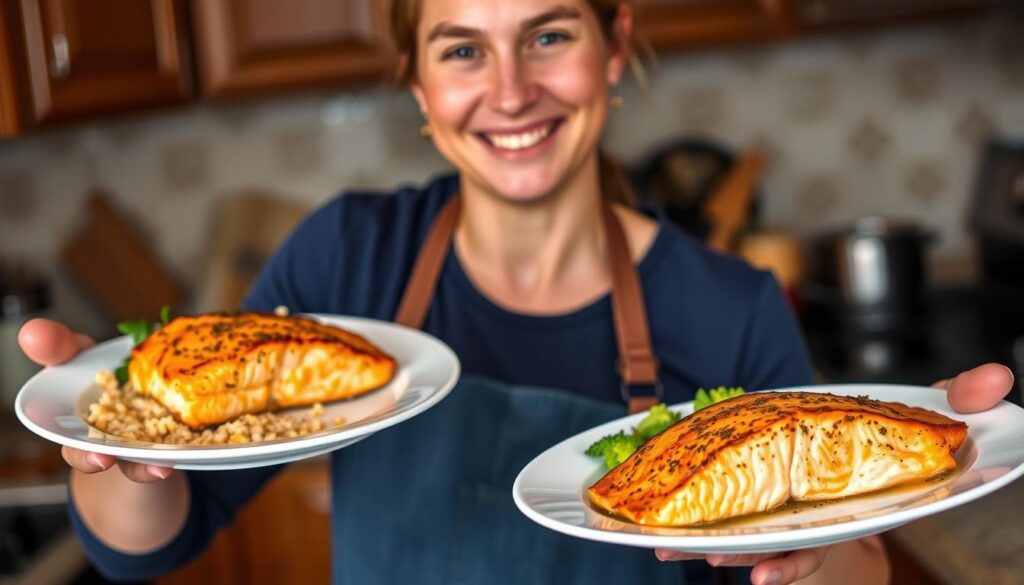
We’d love to hear about your salmon cooking adventures! Rate this recipe below and let us know which method worked best for you. And don’t forget to subscribe to our newsletter for more family-friendly recipes and cooking tips delivered straight to your inbox.
Never Miss a Recipe!
Join thousands of families who follow us on Instagram for weekly recipe inspiration and more delicious ideas.

